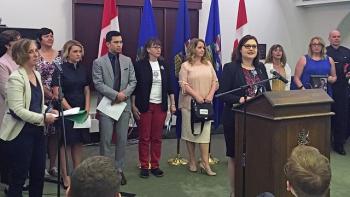Image Caption
By Shari Narine
Windspeaker Contributor
EDMONTON
Dr. Esther Tailfeathers believes the Blood Nation has something to offer the rest of Alberta as the province struggles with an opioid crisis.
“We have experience on the Blood Reserve. It’s kind of like a mini-environment of what’s happening all over Alberta,” she said.
Tailfeathers was one of 14 people introduced May 31 as part of the Opioid Emergency Response Commission.
The new commission is co-chaired by Dr. Elaine Hyshka, scientific director of the Royal Alexandra Hospital’s Inner City Health and Wellness Program, and Dr. Karen Grimsrud, Alberta’s chief medical officer of health. The commission is tasked with accelerating Alberta’s ability to increase treatment, including providing more access to opioid replacement therapy.
“Dr. Esther Tailfeathers, a physician who works with the Kainai First Nation, brings extensive experience from seeing firsthand the devastating impact of opioids on the First Nation south of Calgary,” said Associate Minister of Health Brandi Payne.
That devastation was chronicled by an increased number of Blood members overdosing.
In 2014, the emergency medical services on the Blood Reserve were attending five to seven overdoses per week.
“It quickly escalated, and at one point on one day they attended to 25 overdoses in July of last year,” said Tailfeathers.
Overdoses spike when there is money in community, on days when social services, child tax benefit, or band distributions are paid out, she notes.
The community began to take action.
Tailfeathers points out that the Blood Nation was the first to distribute NARCAN and naloxone kits to non-professionals; the first to undertake community-wide education on the reserve; and the first to open clinics to provide opioid replacement therapy with Suboxone. All these actions have since been embraced by the province.
But even with these initiatives, whether on the Blood Reserve or in the province, the number of deaths continue to grow although Minister Payne is adamant that the situation remains a “crisis” and not an “emergency.”
“We’re saving lives, but we’re still losing people who are not accessing the help that they need. But it’s a huge problem that needs multiple answers,” said Tailfeathers.
She adds that the opioid crisis is also having an impact on pregnant moms. In 2014, 23 of 100 babies born to Blood member women were substance-dependent, the majority affected by alcohol, fentanyl, marijuana or crack cocaine. In 2016-2017, that number jumped to 39 out of 100 babies.
More young people are abusing substances, said Tailfeathers, and many women who are substance-dependent are not using contraceptives.
Although the opioid crisis began with marginalized people, Grimsrud says it has become widespread, impacting every demographic in the province and every user, from occasional to addicted.
The province has provided the commission with $30 million. Measures that are underway to address the crisis include more treatment beds; funding for Suboxone; and more support for first responders and law enforcement agencies. The province is waiting for federal approval for four safe injection sites in Edmonton.
The commission’s direct impact on reserves is limited, but if recommendations are implemented province-wide they will help those who live on-reserves, as they have access to all services from Alberta Health.
Tailfeathers notes the commission could encourage physicians to open clinics on reserve to deliver Suboxone.
Health Canada is already supporting harm reduction on reserve, which allows public health nurses to access naloxone kits through the province and distribute them. Pharmacies on reserve can also hand out naloxone kits without prescriptions. But on-reserve services are limited, she says.
“But Indigenous people also have to come up with their own strategies because we certainly are a different population in terms of the history that led us to the opioid crisis,” she said.
While saving lives and stabilizing people who have addictions are the priorities, Tailfeathers says more needs to be done in Indigenous communities.
“We have to start working at the deeper problems. And with Indigenous people the two things that are most significant are poverty and … intergenerational trauma which started with residential schools,” she said.
Tackling those deeper, emotional problems will mean looking at alternative measures. While abstinence from opioid use is obviously the end goal, Tailfeathers points out that harm reduction and understanding that the battle is long-term are the first steps.
“It’s a slow and methodical shift from being on opioids from getting off of those opioids. It’s also looking at alternatives for pain management and a lot of stabilization of emotional trauma. And working on a different level than prescribing,” she said.
Tailfeathers admits that the grief and loss that families have suffered is often times overwhelming.
“It’s really hard not to get depressed but it’s really important to keep working to make the change. You can’t give up,” she said.

